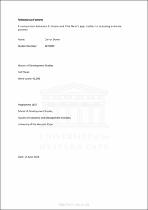| dc.description.abstract | The World Bank working paper ‘Grow, Invest, Insure’ published in 2016 outlines a three-point plan to reduce extreme poverty to three percent by 2030. Specifically highlighting the achievements of Ethiopia in Africa and Viet Nam in South-East Asia, the plan maintains a growth-first strategy to reducing extreme poverty, while emphasising the importance of investment in human capital to aid productivity and complementary social insurance. This thesis reviews the three-point plan compared with approaches to reduce extreme poverty and outcomes observed in Ethiopia and Viet Nam in the period 2000-2015. Results from a synthesis of literature and data for Ethiopia and Viet Nam shows that, while growth-first strategies can be successful in reducing poverty, context is critically important. Both countries were sufficiently comparable in their population and political contexts and followed similar agriculturally led economic growth strategies. Both countries implemented campaigns to reduce extreme poverty over similar periods, through centrally managed regimes. However, where economic growth in Viet Nam catalysed economic transformation that enabled the expedient and sustained reduction of extreme poverty by 2015, Ethiopia exhibited only early suggestions of transformation and a strong tendency for transitory poverty escapes. Both case studies also clearly demonstrated that economic growth alone does not reduce extreme poverty. Transversal policy coordination and implementation that prioritises the targeting of integrated packages of support to the extreme poor, and offers graduated escapes to poverty, are required in order to enable households to exit poverty. These packages of support are both costly and complex to deliver. Where economic growth in a single nation cannot support them, macro-economic reform and political are insufficient to deliver effectively on extreme poverty reduction. Specific effort was made to confine the period of review and to draw on sources that the World Bank researchers would have been privy to whilst drafting their plan, in order to test the validity of the claims made by the authors of the plan. Considering the wealth of information available during the development of the three-point plan, which clearly demonstrates the inconclusive nature of its recommendations, this thesis raises questions about how the authors of the three-point plan justified their approach. | en_US |

